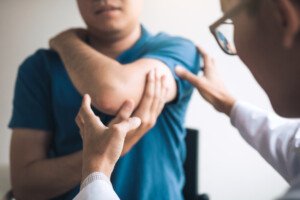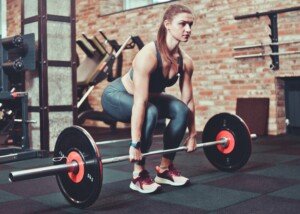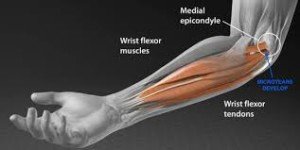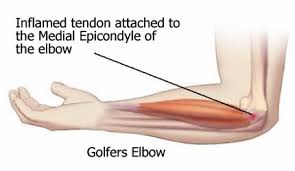
Here is how I cured stubborn golfer’s elbow: just two exercises.
I had golfer’s elbow for many months and months that didn’t respond well to rest, avoidance of offending activities or massage.
“Golfer’s elbow is layman’s terms for medial epicondylitis, which refers to pain and inflammation of the common flexor tendon of the forearm where it inserts on the inner portion of your elbow,” says Dr. Logan Thomas, a physical therapist in Parker City, IN.
I cured my golfer’s elbow with the following two exercises: the farmer’s walk and the deadlift.
My golfer’s elbow was such that if I deadlifted only 60 pounds, I could feel the aggravation in the tendon. So I started at 40 pounds—which felt “clean.”
I began farmer’s walks with just 10 pound dumbbells, because at 15 pounds, I kind of began “feeling it.”
The Deadlift
Before employing the deadlift for your therapy, make sure your form is PERFECT. Practice with a light bar or even a wooden pole.

The deadlift. Shutterstock/Vladimir Sukhachev
Once you know exactly what you’re doing, then find the amount of weight that enables you to do eight repetitions without feeling any hint of the golfer’s elbow—none of it even tapping on your door, so to speak.
Yet at the same time, this weight should be close to that threshold in which you would begin feeling the tendon problem tapping at your door. If you can “feel it” at all, reduce the amount of weight!
Do five sets, eight reps, with two minutes of rest in between.
And during the course of this therapy, you must avoid all offending activities, whether it’s golf, certain weightlifting exercises, certain household tasks, yardwork and what-have-you.
Do the deadlifting twice a week, with three days separating each session. Every few weeks, add 10 pounds.
If the golfer’s elbow taps at your door, back down on the weight load — go back to what you’ve been doing. Never increase by more than 10 pounds.
As you can see, at this rate, it will be a LONG time before you’re deadlifting 135 pounds. Do not let this discourage you.
When I had realized I had golfer’s elbow, I could not deadlift 60 pounds without “feeling” this damage.
However, as a result of sticking to this careful program that requires a lot of patience, I was eventually pulling 225 pounds for eight reps WITHOUT feeling any hint of the golfer’s elbow.
I’ll admit, it had seemed like forever that I was using a barbell of less than 95 pounds, but I’m sure glad I just stuck it all out.
I increased the rest time to three minutes once I got over 100 pounds.
Farmer’s Walks
Because 10 pounds in each hand is so light for this exercise, I did it nearly every day.
Once I got up to a 25 pound dumbbell in each hand, I reduced it to three times a week.

The farmer’s walk. Shutterstock/DisobeyArt
Simply walk for about two minutes. If you can “feel” the golfer’s elbow, use lighter weights.
Increase the dumbbell weight no more frequently than once a week, and do so with two and a half pound increments.
I went from 10 to 12 to 15 to 17 to 20 to 22.5 to 25.
It took a long time to get up to 25, because — and I can’t say this enough — you must use a weight load that’s below the threshold, but close to it.
Eventually I was carrying a 70 pound dumbbell in each hand without feeling the slightest hint of the golfer’s elbow.
Ancillary Exercises for Curing Golfer’s Elbow

Don’t rely on just the deadlift and farmer’s walk once you begin feeling the injury really improving.
At some point, you’ll want to reintroduce other offending exercises, such as the lat pull-down and the seated cable row.
START LIGHT. If you’re deadlifting 135 for reps, don’t assume you can just jump into a 100 pound seated cable row or 135 pound lat pull-down.
The motions of these two new exercises involve a different pattern of muscle recruitment, and thus, even if you can deadlift 150, a lat pull-down of only 75 might aggravate your golfer’s elbow.
Do not use a wide grip on the lat pull-down. Use a medium overhand and underhand grip with the long bar, as well as using a V attachment.
Apply the same principle outlined earlier: Work below the threshold, and very, very gradually increase weight — and I mean gradually. Do eight reps, five sets, a few minutes in between sets.
For the cable row, use a V attachment and apply the same principle.
Be patient and your golfer’s elbow will likely be cured. If over time, there’s no improvement, then you’ll want to seek professional intervention.
 Dr. Thomas a physical therapist, and strength and conditioning coach who is passionate about patient education. He believes the most important and often overlooked step in the process to becoming pain-free is understanding the anatomy and biomechanics of your body.
Dr. Thomas a physical therapist, and strength and conditioning coach who is passionate about patient education. He believes the most important and often overlooked step in the process to becoming pain-free is understanding the anatomy and biomechanics of your body.
 Lorra Garrick is a former personal trainer certified through the American Council on Exercise. At Bally Total Fitness she trained women and men of all ages for fat loss, muscle building, fitness and improved health.
Lorra Garrick is a former personal trainer certified through the American Council on Exercise. At Bally Total Fitness she trained women and men of all ages for fat loss, muscle building, fitness and improved health.
.


























